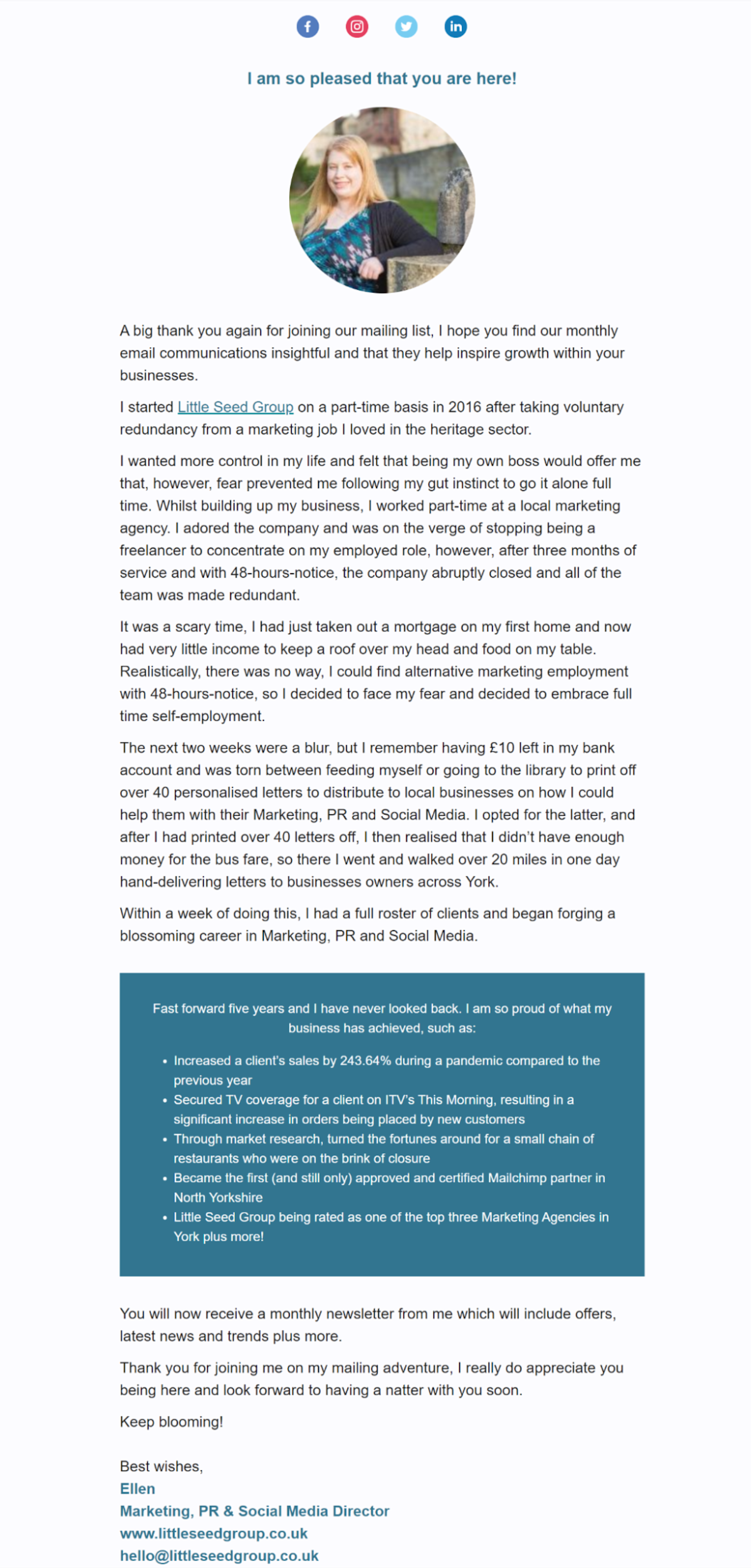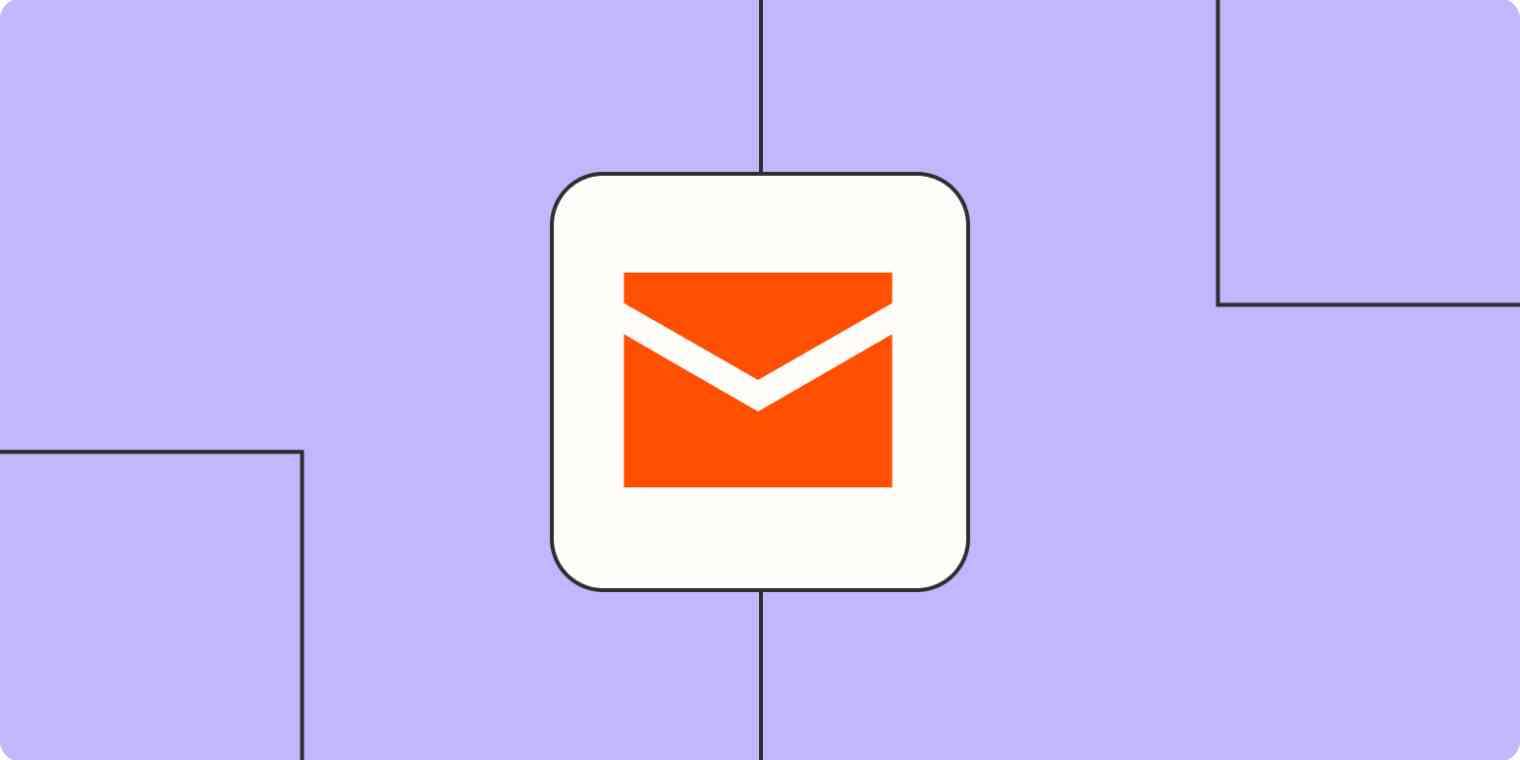Email automation seems like the exact opposite of personal communication. What could be less intimate than an email that's sent by a robot?
But in practice, email automation can actually increase your personal connection with your audience: it lets you communicate with them in a way you wouldn't be able to otherwise, and gives them more opportunities to reach back out to you too.
As the founder of Little Seed Group, a marketing, PR, and social media agency that specializes in helping small to medium enterprises, charities, and solopreneurs, I know that that getting personal is even more important for small businesses. Building a core group of loyal customers has helped us and our clients grow and thrive, especially as we move through a pandemic.
Here's my advice for how to use email automation in a way that will build a connection and nurture those important relationships.
1. Start your customer journey with a welcome series
Have you ever met someone and instantly knew that you'd be kindred spirits? That's what you want your customers to feel, and it's why the beginning of your subscribers' email customer journey is essential. Welcome series aren't just about creating brand awareness—they encourage an emotional connection.
Inform your subscribers
Your welcome automations really are like a first date. They set the tone for the rest of your email campaign and can determine whether subscribers will continue opening your emails.
To avoid being ghosted by your subscribers, you need to demonstrate two things:
Your email content provides value
Your product or service provides value
Yes, it all comes down to value: let customers know what you have to offer them. They're already interested in your business; otherwise they wouldn't be on your mailing list. But perhaps they don't know the full range of what you have to offer. Or you might have some amazing blog content that will genuinely help them. Be direct—let them know this.
We tested a three-day introductory email automation series for one of our charity clients. It included the following information:
Why there's a need for their services
How they benefit the local community
How subscribers can get involved
As a result, 1 in 8 subscribers began volunteering, provided a one-off donation, or set up a standing order.
This direct sort of introduction is effective for any business type. Our welcome mailer series at Little Seed Group has two parts. Part one is automated to send one hour after a user subscribes to our email list. This email lets subscribers know exactly what sorts of emails they'll be receiving, how often they'll receive them, and thanks them for joining us. This sets us up to be trusted, as subscribers know that we won't be spamming them with irrelevant content, and shows that we appreciate their time.
Share your business's story
Part two, sent 24 hours later, shows a more personal and vulnerable side to our business by sharing our company's origin story.
I began Little Seed Group with my last £10 after taking voluntary redundancy. I hand-delivered letters to businesses I wanted to work with, and within a week, I had a full roster of clients. It's a pretty compelling story, I think, and so I tell it in my welcome series.

Ask yourself: what is it about my story that readers will be able to relate to and form a connection with? It might be a story of overcoming obstacles. It might be a grabby "aha" moment. It might just be a strange path you took.
Whatever it is, your story should demonstrate your business's values. It gives you a chance to show off what makes you unique and brings you down to earth. By showing the face of your business, your email campaigns become personal, rather than a cold attempt at selling. Learn more about how to use storytelling in your email marketing.
2. Segment your audience to send personalized messages
Splitting up our audience into segments based on their interests and purchase history allows us to send super-targeted emails. This has hugely boosted our engagement, as it allows us to tailor an individual email subscriber's customer journey toward a purchase.
But how do you get the customer information you need in order to segment?
Surveys
For starters, you can ask them. Make sure you're GDPR-compliant—breaching trust, and the law, won't get you anywhere. In any survey, you should make it clear:
How your customers' data will be used
Who will have access to it
How it will be stored and for how long
Asking your email subscribers to provide you with more personal information, such as their birthday, location, and interests, can be really useful in creating more personalized email automations. Surveys can be sent out as an automation themselves, or you can ask for more information when individuals first subscribe.
Purchase history
You can also use data you already have. For example, we sent a targeted automation to our subscribers who hadn't signed up for a workshop or consultancy with us. We offered them a no-obligation 20-minute consultation to discuss whether our new eLearning course was right for them. This has resulted in a 50% increase in eLearning signups, and it gave us a chance to network with new clients.
Campaign data
Keeping track of who's opening and clicking your email campaigns is key, as it will show you what each individual subscriber is looking for.
Here's an example. We noticed that some of our subscribers engage more when we send blog posts about SEO and links to our SEO services. So we provided more SEO blog content to these subscribers and offered exclusive 20-minute consultancies to help them decide if our SEO services were right for them.
If your partner was hinting that they wanted an intimate dinner out for their birthday, you wouldn't set up a surprise party, right? Show your subscribers that you really care about what they're interested in.
By the way, we use Mailchimp to segment in these ways, but other email marketing tools will do the same. Check to see what kinds of segmentation options your app has, and if it's not cutting it, it might be time to try a new app.
3. Add value for your subscribers
I mentioned that your welcome series should make it clear that you offer value for your subscribers, but it's not enough to say it: you actually need to offer that value.
So before sending an email, ask yourself, is it providing value to those you're sending it to?
Here are some examples of targeted automations that have not only strengthened customer relationships for us but have also resulted in conversions—which, of course, is our ultimate goal.
Birthday mailers
Birthdays are a great opportunity to make your subscribers feel special. Keep in mind that, because of this, subscribers are likely to receive a fair few birthday emails. So make sure yours doesn't seem like just another automation: gift them something that they will genuinely want.
We personally offer a birthday discount on our social media audit service, something which most of our potential clients can make use of. Discounts are generally a good option, and if you have enough information about your subscribers, you can even automate the process of sending a discount on a product or service they're more likely to want, based on the data you have.
For a charity client, we let subscribers know that they could host a birthday fundraiser for the charity on Facebook, with all fees waived. With this initiative, fundraisers through Facebook and alternative channels grew by 12% in 2019, and a further 29% during 2020. And getting customers to do an initial birthday fundraiser encouraged them to do the same every year.
Loyalty rewards
If you create an audience segment based on your most valued customers—perhaps those who have made the most purchases in the last year—you can then use email automations to show that you appreciate them.
These sorts of automations can help you to do more than nurture customer relationships. Recently, we sent a targeted email to all our customers who have used our consultancy or workshop services in the last year. We offered them a free 30-minute consultancy in exchange for a Google Review. Google Reviews are hugely important for SEO rankings and can be difficult to secure. By offering a service that's normally worth £60 in exchange for just two minutes of our clients' time, we demonstrated that we value their feedback, all while making a long-term investment in our SEO strategy.
Get creative with how you reward your loyal customers and you can turn them into brand advocates.
This was a guest post from Ellen Cole, the founder of Little Seed Group and one of Business Insider's top ten UK female social media experts. Want to see your work on the Zapier blog? Read our guidelines, and get in touch.





